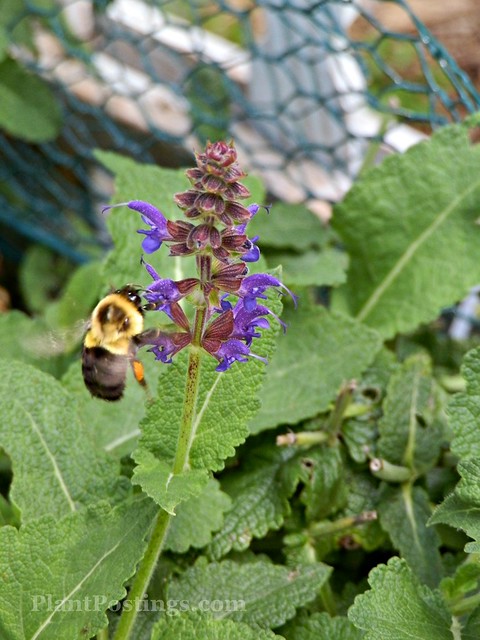Is there a plant in your garden that you're worried won't survive this brutal winter? For gardeners outside the U.S. and Canada, are you concerned about specific plants in your garden for other reasons?
Lately, my Ornamental Sage plants have been on my mind. I'm not sure why, because they're tough perennials! I don't have the original tags, but I believe mine are either Salvia nemorosa or the hybrid Salvia x superba. They've graced the outer corners of my potager garden for about a decade now, and they've always bounced back every spring like clockwork.
 |
| Ornamental Sage in June 2013. |
As soon as they start blooming, the pollinators cover them! I didn't realize until I started cropping the photos for this post that all but two show bumblebees diving in for the Salvias' plentiful nectar! (Can you see them? You can click on the photos to enlarge them.) In fact, it's hard to get a shot of these spikey lavendar/blue beauties without bumbles--not that I've really tried either way.
Ornamental Sages prefer sun, and rich but well-drained soil. They grow to about two feet tall, and form a shrub-like shape. They have a unique scent, similar to other plants in the Mint family, Lamiaceae. And rabbits and deer tend to avoid them.
Why am I worried about these plants? I guess I shouldn't worry because they've survived extreme temperatures and droughts for years. S. nemorosa and its hybrid superba are hardy to zone 5, and some sources say to zone 4. My two clumps are tucked in for the winter with a warm layer of Marsh Hay mulch and soft snow, and they're planted near the house foundation--on the sunny west side of the house.
Still I worry...
 |
| Ornamental Sage in August 2013. After several rounds of deadheading, still plenty of nectar and pollen to go around. |
I can't imagine my garden without them. They've become fixtures--reliable stallwarts that I count on every year.
This "Dummy's Guide" to planting flowers for bees notes that when in bloom, Salvias are "covered with bees all day long." I concur.
In my garden, that means continuous blooms and continuous pollinators from May through August.
But you're more likely to have repeat blooms if you deadhead them. Several times during the season, I spend a little time every few weeks pinching off the spent blooms. I'm not picky, I just grab the garden pruners and start cutting back--usually to the base of each individual stem. Within days, I have blooms again.
I've heard other gardeners say the Ornamental Sages can be floppy. That might be true, but mine are planted with fencing as supports on two sides, and other potager plants on the other sides. And with the regular deadheading, they really don't get floppy at all.
I sure hope they'll be back this spring and summer!





